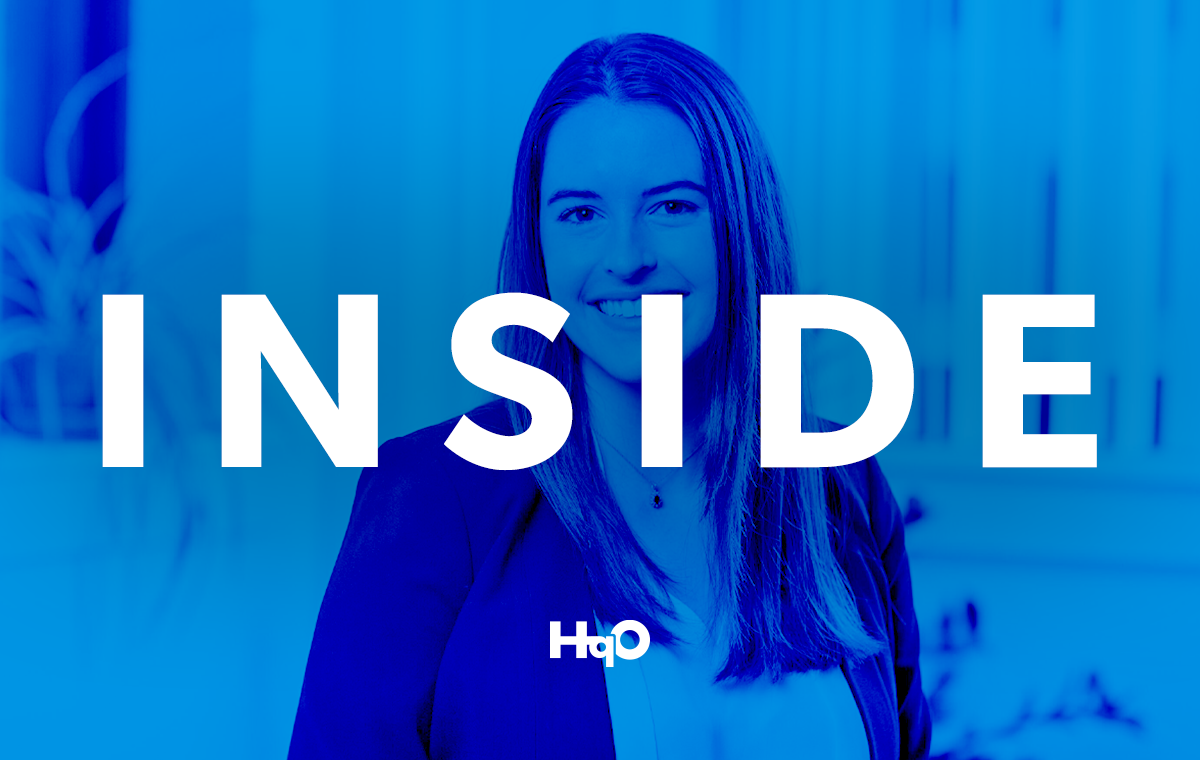Sarah Wright
Customer Success Manager, HqO
As Customer Success Manager, Sarah provides continual support to HqO customers to ensure they have the tools and tactical strategy needed to achieve their workplace experience goals. Prior to joining HqO, Sarah worked in customer and client-facing roles within the financial technology industry. She’s been with the company for over a year and a half.

Thanks for joining us, Sarah! Could you start by describing your role here at HqO? And, related to that, what does your day usually look like?
Absolutely! I work as a Customer Success Manager (also known as a CSM), and I’ve been with HqO for over a year and a half. To be honest, part of the reason I enjoy my role is that my day-to-day varies substantially, with no two days ever being the same. On any given day my schedule is filled with a combination of strategy and educational sessions with customers, preparation and execution of new technology releases, customer education, and a whole host of other customer-based activities.
As a member of the customer success team, I have the unique opportunity to assist in every stage of the customer journey with HqO. From pre-sales to implementation to engagement growth, we have a hand in it all! The members of our team are experts in creating best-in-class workplace experiences and we pride ourselves in the level of care we are able to provide for our customers. We are relentlessly focused on delivering top-tier technology and workplace experience that can meet and exceed our customers’ expectations.
Every day we work to provide ongoing consultation on workplace experience best practices to ensure that customers are reaching their desired outcomes with the help of HqO’s product and services. We utilize feedback, native functionality, third-party integrations, and numerous additional types of functionality to help us achieve these goals.
Can you talk a little bit more about how you handle feedback from customers and end users?
Customer success is interesting because, for many customers, we become the face of a company’s products and services, which means that we get a lot of feedback. In general, that feedback comes from two different groups of stakeholders: one being our application end users, the other being our customers.
When it comes to customer feedback, it typically takes the form of feature requests and ideas for future iterations of the product. This type of feedback is extremely important to us as it helps to inform our internal roadmap and understand the reasoning behind areas of importance for our customers. Every time a new piece of feedback is received, the customer success team ensures that it is reviewed by the appropriate teams and is responded to in a timely manner. We understand that every customer has individual use cases and being able to provide direct feedback helps both parties ensure mutual success throughout the partnership.
When looking at the feedback we receive from app end users, it is commonly collected via our in-app support messaging system or through surveys. If the feedback is a question or feedback related to their workplace then it is routed to our main customer contact to provide further clarification. If the feedback is regarding the app and its functionality, then our customer success and support teams assist in providing a response to the user. In both customer and end-user instances, the solution can vary depending on the nature of the feedback but regardless of where we are collecting the feedback, it goes a long way in supporting HqO’s path forward as we endeavor to make workplace experience the best it can be for all participants.
I know that our customers also receive feedback on their workplaces through the HqO App. Can you tell us a little bit more about how that works? And what’s the value of that feedback, in your experience?
Definitely! When it comes to helping our customers achieve their goals, feedback tends to play a large role in helping to inform strategic decisions for their workplace. While customers gather a variety of different types of feedback, we frequently see customers using HqO’s Tenant Satisfaction tool (also referred to as TSAT) and our micro-feedback surveying functionality to create continuous feedback loops with their end users. These feedback loops first utilize HqO’s TSAT process to pull analytics about tenant or employee sentiment, identify areas of improvement versus high satisfaction, and enable our customers to take action and ensure they are appropriately meeting the needs of their unique tenant base.
From there, we recommend implementing regular micro-feedback surveys to measure the success of the chosen solution. These customizable surveys empower customers to gather feedback on all areas of their workplace.
One thing I have noticed in the industry is that, in many cases, commercial real estate (CRE) landlords and corporate employers have fallen into a one-way communication channel with their tenants or employees. And what we’ve seen is that, ultimately, this can lead to reactive decision-making with little to no data and less effective budget spending.
The value in having a resource to collect regular feedback lies in customers’ ability to gather insights in real-time, so they can maximize workplace investments and better understand employee and/or tenant sentiment. Both TSAT and Micro-Feedback Surveys allow customers to be proactive in their decision-making, ultimately leading to a better understanding of what’s important and insight into retention drivers.
It sounds like you collaborate with a number of teams here at HqO. Is there one team or department you collaborate with the most?
I don’t think I could narrow it down to one particular team! Being in customer success means that I have the chance to work across all departments throughout the various stages of the customer journey with HqO. For example, the Customer Success team works really closely with our Engineering, Product, and Design teams when it comes to new features and app releases. This type of collaboration is super useful for someone in a customer-facing role, as it enables us to share technical knowledge with our customers and help to advocate for their feedback and feature requests internally.
In addition to Engineering, Product, and Design, we also work closely with the Implementation and Sales teams. With Sales, we work in tandem to bolster the customer relationship and promote HqO in the greater industry. When it comes to partnering with the Implementation team, we work to support them in the process of getting a customer from purchase to launch and organizing the addition of new integrations within a customer’s app. Combined collaboration between all of these teams is essential to helping Customer Success provide value to our customers and serve their needs more effectively.
You have a lot of experience working with a number of different stakeholders in the industry. How do you see technology changing or informing the future of commercial real estate?
One of my favorite parts of being in a customer-facing role is that I get to interact with a number of different industry stakeholders, and each one probably has a different opinion on the future of CRE and CRE technology. That being said, it is clear to see that new technologies are dramatically changing the CRE landscape. Within this particular industry, property technology (proptech) is bringing to reality a number of exciting concepts that used to be purely speculative. Incorporating advanced technology into daily operations positions CRE companies to reap the benefits of enhanced operation efficiencies, cost savings, and retention drivers.
When it comes to HqO and our technology, I think that one of the most interesting pieces is the bridge that we’re able to create between digital and physical experiences. Obviously, historically, these used to be thought of as two separate spheres of life, but the pandemic really forced everyone to reconsider the way that they interact with their workplace. This rethinking of the modern office has led to a large boost in proptech development as employees and tenants begin to ask for more sophisticated foundational offerings. Overall, what I am seeing is an immense number of people in commercial real estate acknowledging that, with the rise of hybrid work, there needs to be some kind of bridge between the digital and the physical. That’s where HqO comes into play. Our product is able to bridge the gap between workers and their workplace.
What’s your favorite part of working at HqO?
I think I have to say the culture. The culture was extremely important to me when I was looking for my next opportunity and I could tell right away, even during the interview process, that HqO had a strong, value-driven culture. The values people at HqO embody show in everything; from the way we interact with each other and our customers to the product we put forth in the market. Working with a company that has such a positive workplace culture has provided me with endless motivation, allowed me to work side-by-side with experts in our field, and supported me as I grow in my career.
Interested in learning more about HqO? Consider downloading our new HqO Difference guide to gain a better understanding of HqO’s product.




